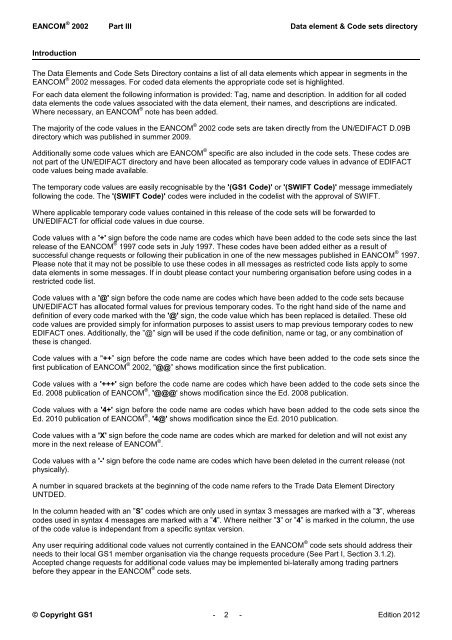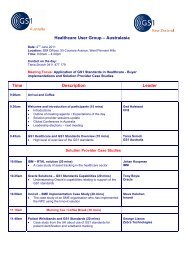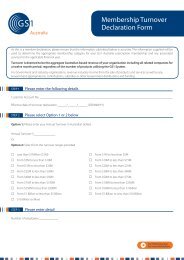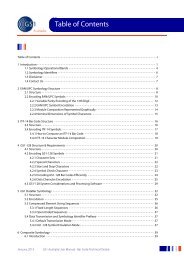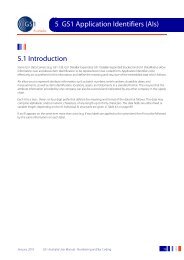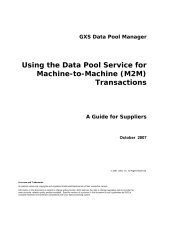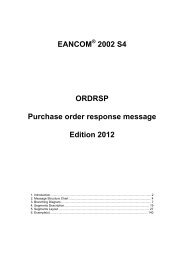Data elements & code sets directory - GS1
Data elements & code sets directory - GS1
Data elements & code sets directory - GS1
You also want an ePaper? Increase the reach of your titles
YUMPU automatically turns print PDFs into web optimized ePapers that Google loves.
EANCOM ® 2002 Part III <strong>Data</strong> element & Code <strong>sets</strong> <strong>directory</strong><br />
Introduction<br />
The <strong>Data</strong> Elements and Code Sets Directory contains a list of all data <strong>elements</strong> which appear in segments in the<br />
EANCOM ® 2002 messages. For <strong>code</strong>d data <strong>elements</strong> the appropriate <strong>code</strong> set is highlighted.<br />
For each data element the following information is provided: Tag, name and description. In addition for all <strong>code</strong>d<br />
data <strong>elements</strong> the <strong>code</strong> values associated with the data element, their names, and descriptions are indicated.<br />
Where necessary, an EANCOM ® note has been added.<br />
The majority of the <strong>code</strong> values in the EANCOM ® 2002 <strong>code</strong> <strong>sets</strong> are taken directly from the UN/EDIFACT D.09B<br />
<strong>directory</strong> which was published in summer 2009.<br />
Additionally some <strong>code</strong> values which are EANCOM ® specific are also included in the <strong>code</strong> <strong>sets</strong>. These <strong>code</strong>s are<br />
not part of the UN/EDIFACT <strong>directory</strong> and have been allocated as temporary <strong>code</strong> values in advance of EDIFACT<br />
<strong>code</strong> values being made available.<br />
The temporary <strong>code</strong> values are easily recognisable by the '(<strong>GS1</strong> Code)' or '(SWIFT Code)' message immediately<br />
following the <strong>code</strong>. The '(SWIFT Code)' <strong>code</strong>s were included in the <strong>code</strong>list with the approval of SWIFT.<br />
Where applicable temporary <strong>code</strong> values contained in this release of the <strong>code</strong> <strong>sets</strong> will be forwarded to<br />
UN/EDIFACT for official <strong>code</strong> values in due course.<br />
Code values with a '+' sign before the <strong>code</strong> name are <strong>code</strong>s which have been added to the <strong>code</strong> <strong>sets</strong> since the last<br />
release of the EANCOM ® 1997 <strong>code</strong> <strong>sets</strong> in July 1997. These <strong>code</strong>s have been added either as a result of<br />
successful change requests or following their publication in one of the new messages published in EANCOM ® 1997.<br />
Please note that it may not be possible to use these <strong>code</strong>s in all messages as restricted <strong>code</strong> lists apply to some<br />
data <strong>elements</strong> in some messages. If in doubt please contact your numbering organisation before using <strong>code</strong>s in a<br />
restricted <strong>code</strong> list.<br />
Code values with a '@' sign before the <strong>code</strong> name are <strong>code</strong>s which have been added to the <strong>code</strong> <strong>sets</strong> because<br />
UN/EDIFACT has allocated formal values for previous temporary <strong>code</strong>s. To the right hand side of the name and<br />
definition of every <strong>code</strong> marked with the '@' sign, the <strong>code</strong> value which has been replaced is detailed. These old<br />
<strong>code</strong> values are provided simply for information purposes to assist users to map previous temporary <strong>code</strong>s to new<br />
EDIFACT ones. Additionally, the ”@” sign will be used if the <strong>code</strong> definition, name or tag, or any combination of<br />
these is changed.<br />
Code values with a "++” sign before the <strong>code</strong> name are <strong>code</strong>s which have been added to the <strong>code</strong> <strong>sets</strong> since the<br />
first publication of EANCOM ® 2002, "@@” shows modification since the first publication.<br />
Code values with a '+++' sign before the <strong>code</strong> name are <strong>code</strong>s which have been added to the <strong>code</strong> <strong>sets</strong> since the<br />
Ed. 2008 publication of EANCOM ® , '@@@' shows modification since the Ed. 2008 publication.<br />
Code values with a '4+' sign before the <strong>code</strong> name are <strong>code</strong>s which have been added to the <strong>code</strong> <strong>sets</strong> since the<br />
Ed. 2010 publication of EANCOM ® , '4@' shows modification since the Ed. 2010 publication.<br />
Code values with a 'X' sign before the <strong>code</strong> name are <strong>code</strong>s which are marked for deletion and will not exist any<br />
more in the next release of EANCOM ® .<br />
Code values with a '-' sign before the <strong>code</strong> name are <strong>code</strong>s which have been deleted in the current release (not<br />
physically).<br />
A number in squared brackets at the beginning of the <strong>code</strong> name refers to the Trade <strong>Data</strong> Element Directory<br />
UNTDED.<br />
In the column headed with an ”S” <strong>code</strong>s which are only used in syntax 3 messages are marked with a ”3”, whereas<br />
<strong>code</strong>s used in syntax 4 messages are marked with a ”4”. Where neither ”3” or ”4” is marked in the column, the use<br />
of the <strong>code</strong> value is independant from a specific syntax version.<br />
Any user requiring additional <strong>code</strong> values not currently contained in the EANCOM ® <strong>code</strong> <strong>sets</strong> should address their<br />
needs to their local <strong>GS1</strong> member organisation via the change requests procedure (See Part I, Section 3.1.2).<br />
Accepted change requests for additional <strong>code</strong> values may be implemented bi-laterally among trading partners<br />
before they appear in the EANCOM ® <strong>code</strong> <strong>sets</strong>.<br />
© Copyright <strong>GS1</strong> - 2 - Edition 2012


